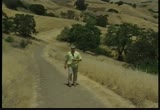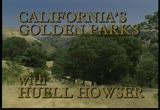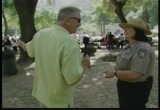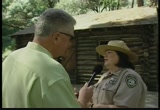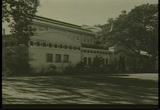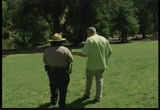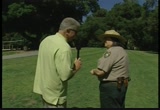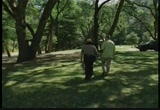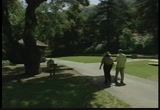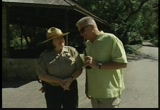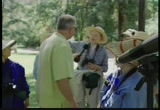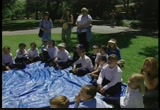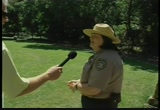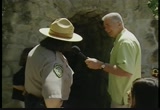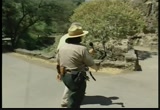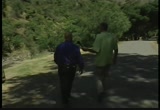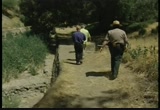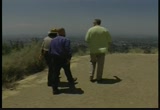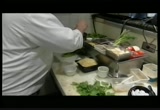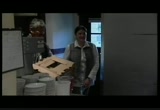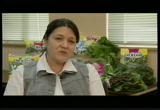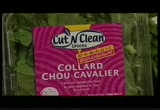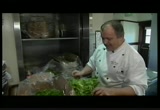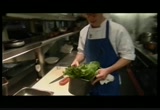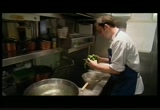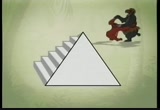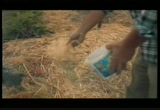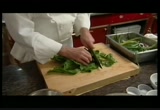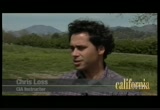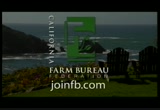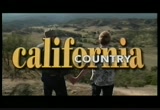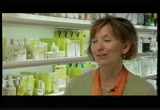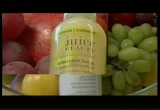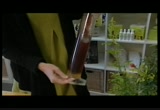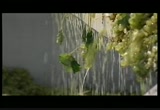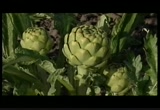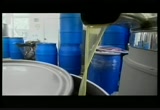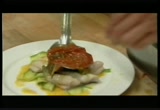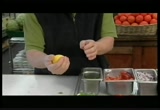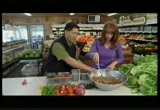tv Democracy Now LINKTV October 2, 2012 3:00pm-4:00pm PDT
3:30 pm
>> coming up on "california country," who said it isn't easy being green? not these folks. >> et voila. >> then we'll go behind the scenes to show you where some of the best chefs in the world go to school. >> i've had my time in the sun, as it were, and now, it's time for me to help other people get there. >> next, if you think beauty is only skin deep, wait until you see what this product is made of. >> you have no idea what you're doing for women and men. >> finally, it's time to salsa with our produce expert. it's all ahead, and it starts now. [captioning made possible by california farm bureau federation] >> so you think great tasting food like this can't be great for you? well, the folks here in ventura county have a very simple message for you. just
3:31 pm
give greens a chance. just give them a chance. everyone wants to look good, feel better, and have more energy, and that's where these guys come in--dark, leafy greens. nutritionists call them the superheroes of the vegetable world. they say they are packed with vitamins "a," "c," and "k," as well as iron, calcium, and fiber. and because of all of that nutritional appeal, what started out more as a comfort food has found acceptance amongst the masses as of late, yet few of us quite know what to do with them when we see them in the store--unless, of course, you're in ventura at the 71 palm restaurant. that's where you couldn't find a bigger fan of dark, leafy greens than chef poireir. >> ok. we got a baby bok choy. beautiful. nice and pretty. we got a bit of chard right now, the red and the green. just direct from the farm. et voila. >> it's like a whirlwind in the kitchen with this chef as he
3:32 pm
makes cooking with greens actually look easy. take, for example, this dish. he adds noodles and a little white wine reduction with some sweet pea greens, and then finishes with sesame seeds, and presto-- an easy and simple dish that any of us could do. >> oh, i love to play around and, you know, create some dish by themselves, just a vegetable or incorporate in a gratin or with some fish and chicken. so i get a variety of a fresh vegetable direct from our gardens, from the oxnard field, ventura field, and to the restaurant, to the plate, to the customer. >> so what's his tip to finding so many ways to cook with greens? well, his main secret to success lies with his friends and neighbors, roy nishimori and jan berk, who run san miguel produce and have almost every green you could imagine at their farm in nearby oxnard which, in turn, provides the chef with a lot of great ideas. >> here we have the baby bok
3:33 pm
choy in a soy ginger sauce. fabulous. and here, we have capellini with the sweet pea. >> besides selling to local chefs, san miguel produce is actually behind one of the most innovative products in the leafy greens market for consumers these days--bagged cooking greens. launched in 1996, it was the first packaged form of cooking greens in the united states. the idea all goes back to the 1970s when roy and his 2 partners were in the vegetable and lettuce business and saw the trend in the bagged salad market and wondered if there wasn't something else they could grow to distinguish themselves from the pack. >> after looking at some of the research, said there might be a market for this. so in 1995 was when we started to transition more of the ground to dedicated toward these leafy greens--the collards, mustards, turnips, kales. now--which was-- now we're up to about 17 different varieties, including organics.
3:34 pm
>> we're out here in a collard field. we grow collards year round here in california. it happens to be one of our biggest commodities for cooking greens. the crew out here today is hand-harvesting the various products. what they do is, they pull the outer leaves off, they bunch them, trim them, put them in the boxes, and we sell these to various grocery stories across the country. yeah. the leaves look really good. quality looks good. >> in addition to those collard greens, which have a cabbage broccoli-like flavor, some of their best sellers are a curly mustard, which is spicy and vibrant, and a rainbow chard, which has a delicate taste similar to spinach. it takes about 35 to 40 days to grow a crop of greens, and then, harvest crews move in and are
3:35 pm
able to get 3 to 4 harvests a year out of the plants. from there, they travel to the production plant, where they are triple washed and cleaned and then put through what amounts to a huge salad spinner. look at that thing. and then, they are bagged up and shipped out for us to enjoy at home. >> when consumers get the product at the stores, obviously, they want it to last fresher as well. so if we, at our end, as farmers, do our job, we can get the product to the grocery stores in the best possible shape, the consumers buy the product, they can take it home, put it in the refrigerator, and hopefully, they will consume it quickly. >> and that's what the beauty of it. so sometimes, we don't know where our vegetables come from-- from somewhere in america, you know? and so, we know it's from direct--from a few miles away here. so that's what's nice. >> today, the farm is the number one-selling brand of cooking greens in the nation, selling to local chefs like chef poireir as well as shipping across the country to stores like
3:36 pm
trader joe's and whole foods for the home cook to devour. but no matter how big they get, the vision here remains the same--to provide folks with an easy solution for adding nutritious and delicious greens to their diet. you know, i have to say, going green never tasted so good. >> and it rewards, because there's nothing better than knowing that you're doing something good for people and helping to feed people, which is very special. >> hi. my name is guillaume bienaime from restaurant marche in menlo park. and today, we're going to be cooking some spicy indian mustard greens. so these mustard greens have been washed. we have about a pound here. and the first thing we're going to do is blanche the greens. and the reason we're blanching them is so that we can start working with a product that's a little smaller in volume here. and these won't take very long, so either blanching, or if you have a steamer at home, you could steam them as well. and then, i'm just going to strain them
3:37 pm
out... and to stop the cooking process, we're just going to get them into a little bit of ice water. so we're serving these greens today with some spanish chorizo, which is kind of a spanish-style salami. then we'll slice our garlic. going to take our shallot here. the one thing you can do which is really nice is that you can kind of blanch your greens and make your oil ahead of time, and then put it all together when your guests get to your house or when you're ready to eat. add our garlic and shallot. then we take our greens and just squeeze all the moisture out that we can with our hands. and as you can tell, we ended up with not that much. and here, we just want to cut, you know, about quarter inch increments. here, we're going to add this right into our pan. little bit of salt. want to be careful. the chorizo does have salt in it as well.
3:38 pm
here you have it--spicy indian mustard greens, spanish chorizo, garlic, and shallot. >> brought to you by allied insurance, a member of the nationwide family of companies, which also includes nationwide insurance. on your side. from farm to feast, stay tuned for more of the tempting tastes of california.
3:39 pm
3:40 pm
>> welcome back to "california country," the show that takes you on an all-expense-paid trip to experience the best-kept secrets of the golden state. >> at the world renown culinary institute of america, trainee chefs who are learning their craft in 6 cooking and baking suites are taught several things, including the fact that their day often starts early-- like 5:00 in the morning early. even before the rooster crowed, karl diehn was feeding chickens at the institute's 1.5-acre student-run farm in st. helena, 2 hours north of san francisco. >> make sure they have plenty of water. we usually change it twice, at least twice a day.
3:41 pm
>> then it's time to harvest the potatoes he planted a few months ago. >> last year, we had a lot of different crops, but we didn't have potatoes. so this season, it was definitely something that i wanted to try. >> he came to the institute from the east coast hoping to become a chef, never realizing he'd end up laboring on a farm, learning first-hand all about farming and growing local produce like squash. these colorful blossoms are harvested as well, even if they're not fully open. >> we have a dish which--it's a squash blossom risotto, and with the open ones, we just kind of stir it into the risotto at the last minute, so it kind of wilts, and it swirls around. >> he's one of about 72 students getting an associate degree at the culinary institute, which claims to be the world's premier culinary college. steve ells, who founded the chain chipotle, graduated from the cia in 1990, and cat cora, known internationally as the only female iron chef on the food network's "iron chef america,"
3:42 pm
also graduated from here in 1995. the greystone branch campus opened in st. helena in 1995 and has been continuously producing top-notch chefs. >> coming here to napa, california, there's fresh almost any kind of ingredient, produce, that you would want. fresh herbs--the herb garden here at cia is amazing. >> here, students cultivate edible flowers, vegetables, and fresh herbs. >> it's learning how to plant, what to plant, when to plant it. >> students feel, and i feel, that by producing our own ingredients, we can become better chefs. we'll get to learn a little bit about our food systems and how we interact with our food systems. we're in a unique position to do that. >> people come from all over the world, studying at the institute in the heart of the lush napa valley, getting
3:43 pm
an opportunity to learn how to grow, harvest, and market the produce. much of this early morning's harvest will be sold at the local farmer's market. >> that's what it's all about. it's really understanding the medium, and if you understand the medium, you can better express your ideas through it. >> sales at the stand are pretty brisk, and whatever doesn't sell is donated to local food banks. meanwhile, back at the institute, classes start around 8:00, and karl diehn, now in his traditional chef's uniform, is cooking some of those squash blossoms he harvested about 2 hourp ago, using them in a mussel and prawn dish. the meal is visually stunning and will be served at the institute's wine spectator greyste restaurant. >> it takes a tremendous amount of energy and strength--not just physical strength, but also emotional strength--to maintain the kind of hours and lifestyle of a chef. and i often wondered
3:44 pm
to myself as i was getting older--it's like, what am i going to do? what am i going to do? and i was very fortunate to be able to come here to the cia and teach. i've been here for 11 years. i've had my time in the sun, as it were, and now, it's time for me to help other people get there. >> it's a meal that's cooked, grown, and harvested by students practicing sustainabla culinary methods. in napa valley, charlotte fadipe for "california country tv." >> this segment is brought to you by the california farm bureau federation. the people, the places, the unforgettable tastes of california will be back in a moment.
3:46 pm
3:47 pm
feeding their skin. at sephora in the bay area, the hunt is on for the perfect potion to turn back the hands of time. and thanks to a new product, customers are getting exactly what they asked for. and one thing is for sure--the old adage that you are what you eat takes on an entirely different meaning now. juice beauty is the name of a new product line started by women in the bay area who began to look at skin care from a different perspective. >> [indistinct] organic green apples a little bit? >> ok. um, yeah. yeah, actually. >> yeah. >> some apple. >> it's just really a lot of organic fruits. >> smells like applesauce. >> uh, yeah, but in a good way. i never really thought about what i was putting all over my body. and so, when i became pregnant at a little bit later age--'cause i had developed several businesses--i started really reading ingredients, and i thought, oh, my gosh. i know i can do this better. >> after purchasing the name juice beauty, karen had the catchy name, but now, she needed a catchy product to match
3:48 pm
it. so she teamed up with fellow bay area resident melissa jochim, and together, the two began to sow the seeds of how to make skin care feed our skin from the outside in. >> the name itself, juice beauty, lends itself to, well, what if we do science, do chemistry, differently? most skin care products are based in water. what if we start playing and see what we can do with fruit juice-basing? >> turns out all those fruit and vegetable juice bases that are high in antioxidants and vitamins that are good for our overall health are precisely what the skin needs, too. you see, from the green apple body cleanser to the antioxidant serum, each product in the line has a raw ingredient base of 70% or higher and is packed with freshly squeezed juice concentrate--apples, cherries, pomegranates, grapes, raspberries. you name the fruit,
3:49 pm
and this duo is finding a way for nature to nurture our skin. >> we work with almost 29 different organic fruit juices. that's our start point. and to those juices, you'll see me adding the other 100-plus ingredients that we purchase organically, and those ingredients include everything from plantils to essential oils to herbs to honey. you name it. if we can get it organic, it's finitely on our ingredient listing. >> in the base, melissa usually starts with apple juice, and then adds brighter or darker juices like cherry or grape or pomegranate. and then, depending on what she wants the product to do--cleanse, moisturize, or exfoliate--she'll add things like olive oil or avocado oil, and then, some sugar or honey to keep skin refined and looking as fresh as the ingredients that go into it. >> i always say a woman can wash her face in apple juice, and that she'd have a better result than most cleansers on the market. and this is our way
3:50 pm
of marketing apple juice and juices that will give you a wonderful, effective finish, but they definitely are good for you. these ingredients come from a farm, and every harvest is different. >> you don't have to tell gary kalajian that. at his madera farm in the central valley, more than 2,500 acres of every grape imaginable are carefully raised, tended to, and harvested for a variety of uses, including their newest venture, skin care. the grapes get turned into some of the freshest, purest, highest quality wine products around, which is exactly what karen was looking for when she started juice beauty and found gary to be one of her farmers and raise fruit where every drop of it feeds your skin. >> karen, these are thompson
3:51 pm
seedless, and we're going to be harvesting these tonight. >> you know, gary, it's so funny because you're always farming for taste, of course, but we farm for efficacy on the face, so... >> you know, people are astonished, as far as what we've been doing with these products that we're raising. and we're finding other avenues to go with them, which is opening up new markets and opening bigger markets for us. >> and thanks to farm fresh products like the ones gary is growing, juice beauty has gained a celebrity following and is now being launched worldwide, pring that a healthy lifestyle isn't just what we put in our bodies but what we put on them as well. >> so you have no idea what you're doing for women and men out there with the skin products that you're supplying. >> well, i never thought we'd be growing grapes for that. >> for beauty. [laughs] >> for beauty, huh?
3:52 pm
>> today on food 101, we're going to feed our face, but in a good way. we're going to learn what to eat to get healthy skin. and to help us alang the way is dietician here at raley's earline griffith. >> milk has one of the best sources of vitamin "a," and vitamin "a" is one of those antioxidants that will help protect your skin from different types of free radical damage, for example. >> oh, ok. that's a big one. >> artichokes are so good for helping with premature aging of skin, and the reason is they're packed with antioxidants and "b" vitamins. so they're also going to be a good, healthy skin booster. >> ok. so next up--still in the produce section--we're going to be talking about avocados. what do we like about avocados for our skin? >> well, we like avocados because of the lutein that you're going to find in there. and so, we think of lutein as another one of those skin nutrients. >> oh, ok.
3:53 pm
>> and a neat thing about avocado is not only is it good for internally, but if you have, you know, blotchy skin or kind of irritated skin, it's very good for calming. so you can also apply it it onto your face. >> really? so it's topical, too? >> it's topical, too. >> yeah. this is the wonder veggie right here, basically. >> yeah. it makes a great mask. >> ok. ok. so we've moved out of the produce area, and now, where are we, earline? >> we're heading to the california olive oils. >> oh, good. ok. >> now, extra virgin olive oil is a great source of your monounsaturated fatty acids. >> ok. want that one. >> one of the things it's going to do is to help with the strenth of those cell membranes. >> ok. >> so extra virgin olive oil is a very good choice. i also like the fact that it's good for-- as a moisturizer for your skin. >> now, i always thought that was an old wives' tale, but that's true-- >> that is very true. >> ok. >> it's very good for your skin, and it's not going to clog any pores or anything like that. >> oh, good. >> just remember, you know, you
3:54 pm
3:55 pm
>> like the show? you'll love "california country: the magazine," which delivers the best stories from throughout the golden state. visit californiacountry.org for more information. >> welcome back to "california country." >> hello, everyone. i'm glen ikeda, and fortunate for us today, we have a star with us-- tracy sellers from "california country," and she's going to be helping me make a wonderful
3:56 pm
salsa. here at ikeda's, everybody's asking us how do we make great salsa--"why is your salsa so good?" well, that's because we start with the best california ingredients. and here, we start with a tomato, the most important part of the salsa. you want to look for nice red, ripe tomatoes. smell it. smell it for great smell to make sure that the tomatoes are fresh. we add that to the salsa. >> ok. i'll do that. >> good job, tracy. >> thank you. >> next, we have cilantro--nice, vibrant green leaves. want to make sure the stems are cut nice and fresh. feels nice and vibrant. so we throw in a little bit of cilantro. >> little bit or a lot? >> a lot of cilantro. >> oh. it's ok. >> down from south, great eureka lemons. i like to mush the lemon up a little bit, get that juice rolling. cut that in half. i'll squeeze a half a lemon in there. >> ok. [indistinct] >> sweet california red onions. that's the best. to really spice
3:57 pm
it up, we're going to add some of these really sweet onions. >> little or a lot? >> a little. >> ok. ok. [laughs] >> and lastly, to really make sure that the salsa pops, we've got the jalapeno. nice green stems. make sure there's no bruises on them. >> little? >> lots. >> [laughs] you like it spicy. >> great. >> oh, jeez. >> and then, just to make sure that we have the flavor right, we're going to add a little bit of garlic powder. >> ok. >> about a half teaspoon of salt. >> ok. cool. >> nice. about a quarter teaspoon of black pepper. >> black pepper. mix that all in? >> mix that all up. >> now, taste test. >> the best part, right here. great salsa. >> [laughs] >> good job, tracy. >> all right. good job, glen. >> that concludes today's tour
3:58 pm
3:59 pm
151 Views
Uploaded by TV Archive on

 Live Music Archive
Live Music Archive Librivox Free Audio
Librivox Free Audio Metropolitan Museum
Metropolitan Museum Cleveland Museum of Art
Cleveland Museum of Art Internet Arcade
Internet Arcade Console Living Room
Console Living Room Books to Borrow
Books to Borrow Open Library
Open Library TV News
TV News Understanding 9/11
Understanding 9/11